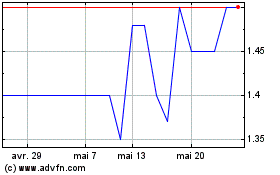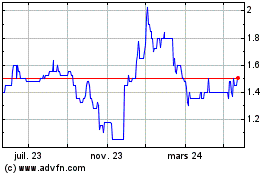Anglesey Mining PLC Annual Financial Report -8-
30 Juillet 2014 - 4:28PM
UK Regulatory
eliminated on consolidation.
Investment in associate
An associate is an entity over which the group exercises, or is in a position
to exercise, significant influence, but not control or joint control, through
participation in the financial or operating policy of the investee. In
considering the degree of control, any options or warrants over ordinary
shares which are capable of being exercised at the period end are taken into
consideration.
Where material, the results and assets and liabilities of associates are
incorporated in the financial statements using the equity method of
accounting, except when these associates are classified as held for sale.
Investments in associates are carried in the statement of financial position
at cost adjusted by any material post-acquisition changes in the net assets of
the associates, less any impairment of value in the individual investments.
Investments in associates cease to be treated as associates using the equity
method of accounting when the group loses significant influence. Any retained
interest is treated as an investment in accordance with IAS 39 `Financial
Instruments: Recognition and Measurement'. The transaction is treated as a
disposal of interest in the associate, with any difference arising between the
fair value of the retained interest, and the carrying value of the associate
at the date significant influence is lost recognised as a profit or loss on
reclassification within the income statement.
Revenue recognition
Interest income is accrued on a time basis, by reference to the principal
outstanding and at the effective interest rate applicable, which is the rate
that exactly discounts estimated future cash receipts through the expected
life of the financial asset to that asset's net carrying amount.
Foreign currencies
Transactions in currencies other than pounds sterling are recorded at the
rates of exchange prevailing on the dates of the transactions. At the end of
each reporting period, monetary assets and liabilities that are denominated in
foreign currencies are retranslated at the rates prevailing on the period end
date. Non-monetary assets and liabilities carried at fair value that are
denominated in foreign currencies are translated at the rates prevailing at
the date when the fair value was determined. Gains and losses arising on
retranslation are included in net profit or loss for the period.
On consolidation, the assets and liabilities of the group's overseas
operations are translated at exchange rates prevailing on the period end date.
Exchange differences arising, if any, are classified as items of other
comprehensive income and transferred to the group's translation reserve within
equity.
Such translation differences are reclassified to profit or loss, and
recognised as income or as expense, in the period in which the operation is
disposed.
Segmental analysis
Operating segments are identified on the basis of internal reports about
components of the group that are regularly reviewed by the chief operating
decision-maker.
Retirement benefit costs
Payments to defined contribution retirement benefit schemes are charged as an
expense as they fall due. There are no defined benefit retirement schemes.
Equity-settled employee benefits
The group provides equity-settled benefits to certain employees.
Equity-settled employee benefits are measured at fair value at the date of
grant. The fair value determined at the grant date is expensed on a
straight-line basis over the vesting period, based on the group's estimate of
shares that will eventually vest and adjusted for the effect of non-market
based vesting conditions.
Fair value is measured by use of a Black-Scholes model. The expected life used
in the model has been adjusted from the longer historical average life, based
on directors' estimates of the effects of non-transferability, exercise
restrictions, market conditions, age of recipients and behavioural
considerations.
Taxation
Deferred tax is the tax expected to be payable or recoverable on differences
between the carrying amounts of assets and liabilities in the financial
statements and the corresponding tax bases used in the computation of taxable
profit, and is accounted for using the period end liability method. Deferred
tax liabilities are generally recognised for all taxable temporary differences
and deferred tax assets are recognised to the extent that it is probable that
taxable profits will be available against which deductible temporary
differences can be utilised. Such assets and liabilities are not recognised if
the temporary difference arises from goodwill or from the initial recognition
(other than in a business combination) of other assets and liabilities in a
transaction that affects neither the tax profit nor the accounting profit.
Deferred tax liabilities are recognised for taxable temporary differences
arising on investments in subsidiaries and associates, and interests in joint
ventures, except where the group is able to control the reversal of the
temporary difference and it is probable that the temporary difference will not
reverse in the foreseeable future.
The carrying amount of any deferred tax assets is reviewed at each period end
date and reduced to the extent that it is no longer probable that sufficient
taxable profits will be available to allow all or part of the asset to be
recovered.
Deferred tax is calculated at the tax rates that are expected to apply in the
period when the liability is settled or the asset is realised. Deferred tax is
charged or credited in the income statement, except when it relates to items
charged or credited directly to equity, in which case the deferred tax is also
dealt with in equity.
Property, plant and equipment
The group's freehold land is stated in the statement of financial position at
cost. The directors consider that the residual value of buildings, based on
prices prevailing at the date of acquisition, is such that any depreciation
would not be material. The carrying value is reviewed annually and any
impairment in value would be charged immediately to the income statement.
Plant and office equipment are stated in the statement of financial position
at cost, less depreciation. Depreciation is charged on a straight line basis
at the annual rate of 25%. Residual values and the useful lives of these
assets are also reviewed annually.
Intangible assets - mineral property exploration and evaluation costs
Intangible assets are stated in the statement of financial position at cost,
less accumulated amortisation and provisions for impairment.
Costs incurred prior to obtaining the legal rights to explore a mineral
property are expensed immediately to the income statement. Mineral property
exploration and evaluation costs are capitalised until the results of the
projects, which are usually based on geographical areas, are known; these
include an allocation of administrative and management costs as determined
appropriate to the project by management.
Where a project is successful, the related exploration costs are amortised
over the life of the estimated mineral reserve on a unit of production basis.
Where a project is terminated, the related exploration costs are expensed
immediately. Where no internally-generated intangible asset can be recognised,
development expenditure is recognised as an expense in the period in which it
is incurred.
Impairment of tangible and intangible assets
The values of mineral properties are reviewed annually for indications of
impairment and when these are present a review to determine whether there has
been any impairment is carried out. They are written down when any impairment
in their value has occurred and are written off when abandoned. Where a
provision is made or reversed it is dealt with in the income statement in the
period in which it arises.
Investments
Investments in subsidiaries are shown at cost less provisions for impairment
in value. Income from investments in subsidiaries together with any related
withholding tax is recognised in the income statement in the period to which
it relates.
Provisions
Provisions are recognised when the group has a present obligation as a result
of a past event and it is probable that the group will be required to settle
that obligation. Provisions are measured at the directors' best estimate of
the expenditure required to settle that obligation at the end of the reporting
period and are discounted to present value where the effect is material.
Financial instruments
Financial assets and liabilities are initially recognised and subsequently
measured based on their classification as "loans and receivables", "available
for sale financial assets" or "other financial liabilities".
Loans and receivables are non-derivative financial assets with fixed or
determinable payments that are not quoted in an active market. They are
included in current assets, except where they mature more than 12 months after
the period end date: these are classified as non-current assets.
(a) Trade and other receivables. Trade and other receivables are measured at
initial recognition at fair value and are subsequently measured at amortised
cost using the effective interest rate method. Appropriate allowances for
estimated irrecoverable amounts are recognised in the income statement when
there is objective evidence that the asset is impaired.
(b) Cash and cash equivalents. The group considers all highly liquid
investments which are readily convertible into known amounts of cash and have
a maturity of three months or less when acquired to be cash equivalents. The
management believes that the carrying amount of cash equivalents approximates
fair value because of the short maturity of these financial instruments.
(c) Available for sale financial assets. Listed shares held by the group that
are traded in an active market are classified as being AFS and are stated at
Anglesey Mining (LSE:AYM)
Graphique Historique de l'Action
De Juin 2024 à Juil 2024

Anglesey Mining (LSE:AYM)
Graphique Historique de l'Action
De Juil 2023 à Juil 2024
